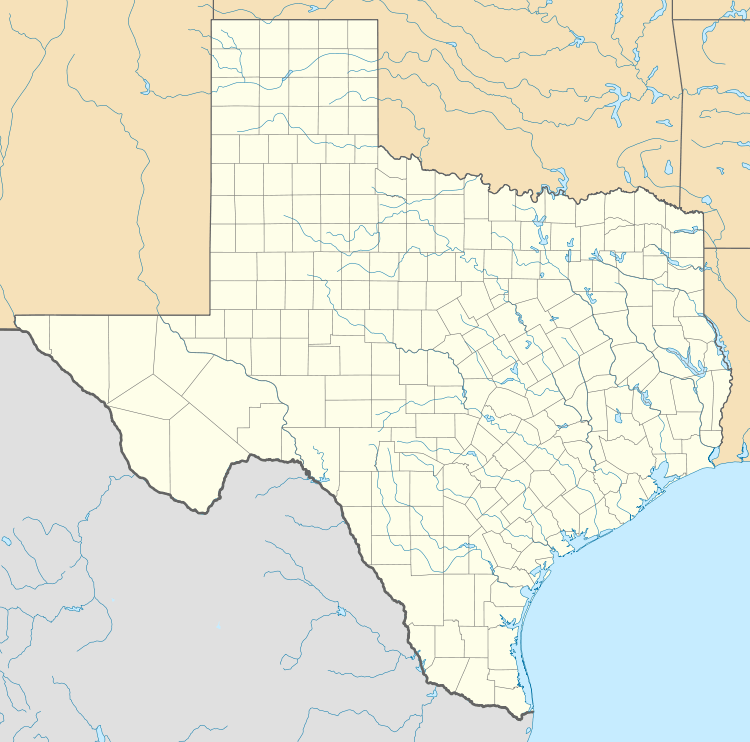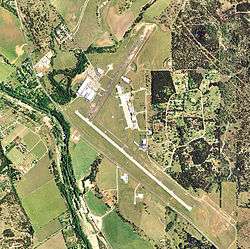Kerrville Municipal Airport
| Kerrville Municipal Airport Louis Schreiner Field | |||||||||||||||
|---|---|---|---|---|---|---|---|---|---|---|---|---|---|---|---|
|
USGS 2006 orthophoto | |||||||||||||||
| IATA: ERV – ICAO: KERV – FAA LID: ERV | |||||||||||||||
| Summary | |||||||||||||||
| Airport type | Public | ||||||||||||||
| Owner | City of Kerrville | ||||||||||||||
| Serves | Kerrville, Texas | ||||||||||||||
| Elevation AMSL | 1,617 ft / 493 m | ||||||||||||||
| Coordinates | 29°58′36″N 099°05′08″W / 29.97667°N 99.08556°WCoordinates: 29°58′36″N 099°05′08″W / 29.97667°N 99.08556°W | ||||||||||||||
| Website | www.KerrvilleAirport.com | ||||||||||||||
| Map | |||||||||||||||
 ERV Location in Texas | |||||||||||||||
| Runways | |||||||||||||||
| |||||||||||||||
| Statistics (2011) | |||||||||||||||
| |||||||||||||||
Kerrville Municipal Airport (IATA: ERV, ICAO: KERV, FAA LID: ERV) (Louis Schreiner Field) is six miles southeast of Kerrville, in Kerr County, Texas.[1] The National Plan of Integrated Airport Systems for 2011–2015 categorized it as a general aviation facility.[2]
History
The airport opened in February 1943 as Louis Schreiner Field and was used by the United States Army Air Forces as a training base. At the end of the war the airfield was determined to be excess by the military and turned over to the local government for civil use. [3] [4] [5] [6]
Trans-Texas DC-3s stopped there until 1959-60.
Facilities
Kerrville Municipal Airport covers 528 acres (214 ha) at an elevation of 1,617 feet (493 m). It has two asphalt runways: 12/30 is 6,000 by 100 feet (1,829 x 30 m) and 3/21 is 3,592 by 60 feet (1,095 x 18 m).[1]
In the year ending August 5, 2011 the airport had 59,800 general aviation operations, average 163 per day. 149 aircraft were then based at the airport: 86% single-engine, 5% multi-engine, 3% jet, 5% helicopter, and 1% glider.[1]
See also
References
- 1 2 3 4 FAA Airport Master Record for ERV (Form 5010 PDF). Federal Aviation Administration. Effective May 31, 2012.
- ↑ "2011–2015 NPIAS Report, Appendix A" (PDF, 2.03 MB). National Plan of Integrated Airport Systems. Federal Aviation Administration. October 4, 2010. External link in
|work=(help) - ↑
 This article incorporates public domain material from the Air Force Historical Research Agency website http://www.afhra.af.mil/.
This article incorporates public domain material from the Air Force Historical Research Agency website http://www.afhra.af.mil/. - ↑ Shaw, Frederick J. (2004), Locating Air Force Base Sites History’s Legacy, Air Force History and Museums Program, United States Air Force, Washington DC, 2004.
- ↑ Manning, Thomas A. (2005), History of Air Education and Training Command, 1942–2002. Office of History and Research, Headquarters, AETC, Randolph AFB, Texas ASIN: B000NYX3PC
- ↑ Thole, Lou (1999), Forgotten Fields of America : World War II Bases and Training, Then and Now - Vol. 2. Publisher: Pictorial Histories Pub, ISBN 1-57510-051-7
External links
- Kerrville/Kerr County Airport at Louis Schreiner Field
- Kerrville Aviation, the fixed-base operator (FBO)
- Kerrville Muni / Louis Schreiner Field (ERV) at Texas DOT Airport Directory
- Aerial image as of February 1995 from USGS The National Map
- FAA Terminal Procedures for ERV, effective November 10, 2016
- Resources for this airport:
- FAA airport information for ERV
- AirNav airport information for KERV
- ASN accident history for ERV
- FlightAware airport information and live flight tracker
- NOAA/NWS latest weather observations
- SkyVector aeronautical chart, Terminal Procedures


